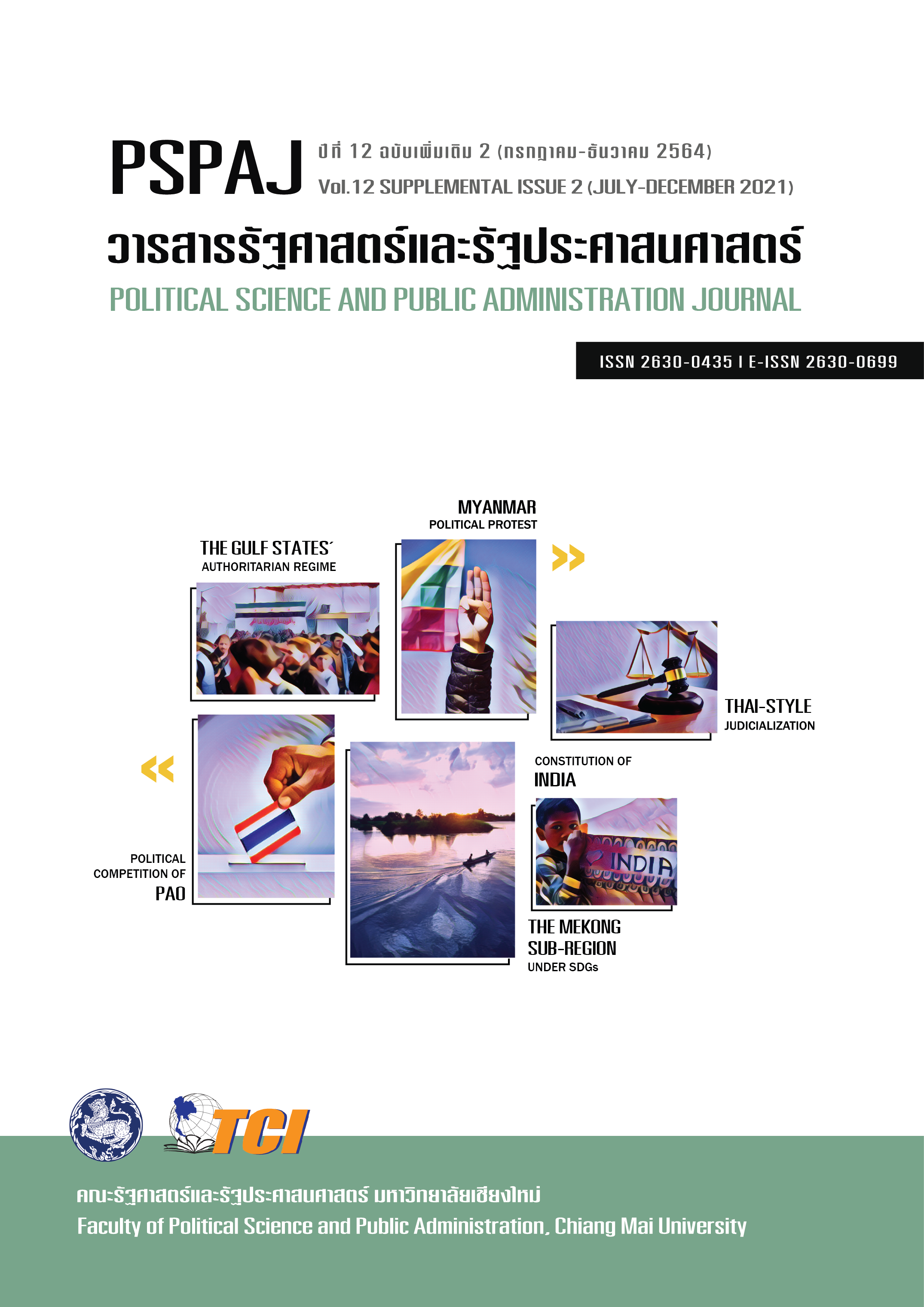Protest and Politicized Collective Identity: A Case Study of "Democratic Identity" Dynamics through Protests in Myanmar
Main Article Content
Abstract
Myanmar is one of the countries facing an identity crisis that people are divided on the basis of ethnic identity. This article argues that the protests that have been taking place in Myanmar since independence have led to the formation of a common political identity. This "democratic" identity became completely social identity when the state shared after the 2010 elections. However, President Thein Sein’s government has played an important role in redefining “democracy”. The new definition, however, shows the influence of the military remains in Myanmar's politics. This argument is based on both documentary and field research focusing on documents and interviews with people involved in the 1974, 1988 and 2007 protests, as well as those during President Thein Sein’s rule. Qualitative data analysis was conducted through a framework of "politicized collective identity", which considers the process of identity building as a form of political struggle to create conceptual ideas on the implications of protest and the current Myanmar politics.
Article Details
- เนื้อหาและข้อมูลที่ลงตีพิมพ์ในวารสารรัฐศาสตร์และรัฐประศาสนศาสตร์ถือเป็นข้อคิดเห็นและความรับผิดชอบของผู้เขียนบทความโดยตรง ซึ่งกองบรรณาธิการวารสารรัฐศาสตร์และรัฐประศาสนศาสตร์ ไม่จำเป็นต้องเห็นด้วย หรือร่วมรับผิดชอบใดๆ
- บทความและข้อมูล ที่ได้รับการตีพิมพ์ในวารสารรัฐศาสตร์และรัฐประศาสนศาสตร์ ถือเป็นลิขสิทธิ์ของวารสาร หากบุคคลหรือหน่วยงานใดต้องการนำข้อมูลไปใช้ประโยชน์ในทางวิชาการ ขอให้อ้างอิงแหล่งที่มาด้วย
References
ณัฐพล ตันตระกูลทรัพย์. (2557). ทุนนิยมกับการพัฒนาประชาธิปไตยในพม่า ใน วิทยา สุจริตธนารักษ์ (บก.). การเมืองและความมั่นคงใหม่ในเอเชีย (น. 25-56). กรุงเทพฯ: สถาบันเอเชียศึกษา จุฬาลงกรณ์มหาวิทยาลัย.
พรพิมล ตรีโชติ, (2542). ชนกลุ่มน้อยกับรัฐบาลพม่า. กรุงเทพฯ: สำนักงานกองทุนสนับสนุนการวิจัย: มูลนิธิโครงการตำราสังคมศาสตร์และมนุษยศาสตร์.
โรเบิร์ต เอช เทย์เลอร์. (2550). รัฐในพม่า (พรรณงาม เง่าธรรมสาร, สดใส ขันติวรพงศ์, และ ศศิธร รัชนี ณ อยุธยา, ผู้แปล.). กรุงเทพฯ: มูลนิธิโครงการตำราสังคมศาสตร์และมนุษยศาสตร์.
วิรัช นิยมธรรม (2555). มโนทัศน์ทางการเมืองของรัฐทหารพม่า. จุลสารความมั่นคงศึกษา, 113, 1-40
Aung, S., & Aris, M. (1991). Freedom from Fear and Other Writings. London: Penguin Books.
Barrington, L. (2012). Comparative Politics: Structures and Choices. Boston, MA: Cengage Learning.
BBC News. (2015, March 5). Myanmar Police Arrest Demonstrators Against New Education Bill. Retrieved March 10, 2021 from https://www.bbc.com/news/world-asia-31754504
Boudreau, V. (2009). Resisting Dictatorship: Repression and Protest in Southeast Asia. Cambridge: Cambridge University Press.
Cheesman, N. (2003). School, State and Sangha in Burma. Comparative Education, 39(1), 45-63.
Edwards, G. (2014). Social Movements and Protest. Cambridge: Cambridge University Press.
Fink, C. (2001). Living Silence: Burma Under Military Rule. London: Zed Books.
Global New Light of Myanmar. (2015, March 27). Speech Delivered by Commander-in-Chief of Defense Services, Senior General Thayaysithu Min Aung Hlaing at the Parade of the 70th Armed Forces Day Held on 27th March, 2015. Retrieved March 10, 2021 from www.gnlm.com.mm/speech-delivered-by-commander-in-chief-of-defence-services-senior-general-thayaysithu-min-aung-hlaing-at-the-parade-of-the-70th-armed-forces-day-held-on-27th-march-2015/
Gravers, M. (2007). Exploring Ethnic Diversity in Burma. Copenhagen: NIAS Press.
Hlaing, K. Y. (2008). Challenging the Authoritarian State: Buddhist Monks and Peaceful Protests in Burma. Fletcher Forum of World Affairs, 32(1), 125-144.
Klandermans, P. G. (2014). Identity Politics and Politicized Identities: Identity Processes and the Dynamics of Protest. Political Psychology, 35(1), 1-22.
Lintner, B. (2009). The Resistance of the Monks: Buddhism and Activism in Burma. New York: Human Rights Watch.
Pye, L. W. (1966). Aspects of Political Development. Boston: Little, Brown.
Sakhong, L. H. (2010). In Defense of Identity: The Ethnic Nationalities' Struggle for Democracy, Human Rights, and Federalism in Burma: A Collection of Writings and Speeches, 2001-2010. Bangkok: Orchid Press.
Seekins, D. M. (2005). The State and the City: 1988 and the Transformation of Rangoon. Pacific Affairs, 78(2), 257-275.
Simon, B., & Klandermans, B. (2001). Politicized Collective Identity: A Social Psychological Analysis. American Psychologist, 56(4), 319-331.
Smith, M. (2007). State of Strife: The Dynamics of Ethnic Conflict in Burma. Singapore: Institute of Southeast Asian Studies.
South, A. (2008). Ethnic Politics in Burma: States of Conflict. New York: Routledge.
Steinberg, D. I. (2012). The Problem of Democracy in the Republic of the Union of Myanmar: Neither Nation-State nor State-Nation? Southeast Asian Affairs 2012, 220-237.
The Irrawaddy. (2018, 26 March). Snr-Gen Min Aung Hlaing’s Armed Forces Day Speeches. The Irrawaddy. Retrieved March 10, 2021 from https://www.irrawaddy.com/news/burma/snr-gen-min-aung-hlaings-armed-forces-day-speeches.html
Tucker, S. (2001). Burma: Curse of Independence. London: Pluto Press.
Valenzuela, J. S. (1990). Democratic Consolidation in Post-Transitional Settings: Notion, Process, and Facilitating Conditions (Vol. 150). Notre Dame, IN: Helen Kellogg Institute for International Studies, University of Notre Dame.


